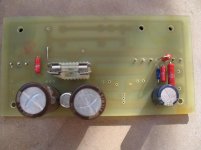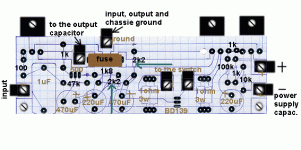Nelson Pass said:
There are those who would argue that this is the weak part of
loop feedback. The composite nonlinearities of many stages
within a loop creates a more chaotic situation for feedback to
deal with, and the result is less predictable. The paradox of
feedback is that it works perfectly with systems that are
perfectly linear, and of course because they are linear, they
don't need feedback. The more you need feedback, the less
reliable the result.
😱
That point is well taken.
BZ
Strong complaint:
Why my post has disappeared ??????????????????????????
What was wrong in content ??????????????????????????????????
Why my post has disappeared ??????????????????????????
What was wrong in content ??????????????????????????????????
Power Follower 99C
Hello
I'm in the process to give a try to the Power Follower 99C .Unfortunately I don't know how to contact to Andrea .
I do not have his E-mail address .
I have a question
On the schematic there is one 2k2 resistor and one 220R
On the layout there is two 2k2 resistor and no 220R .😕
I dont know which one is correct .Can someone help me lease with these problem .
Thank you very much 🙂
Greets gabor
Hello
I'm in the process to give a try to the Power Follower 99C .Unfortunately I don't know how to contact to Andrea .
I do not have his E-mail address .
I have a question
On the schematic there is one 2k2 resistor and one 220R
On the layout there is two 2k2 resistor and no 220R .😕
I dont know which one is correct .Can someone help me lease with these problem .
Thank you very much 🙂
Greets gabor
Attachments
Hello
I'm in the process to give a try to the Power Follower 99C .Unfortunately I don't know how to contact to Andrea .
I do not have his E-mail address .
I have a question
On the schematic there is one 2k2 resistor and one 220R
On the layout there is two 2k2 resistor and no 220R .😕
I dont know which one is correct .Can someone help me lease with these problem .
Thank you very much 🙂
Greets gabor
about
Audio Design Guide
I read:
Use ciuffoly@gmail.com to contact me with Windows Live Messenger to get real-time help on my projects.
and
Use webmaster@audiodesignguide.com to contact me by email to get information on my projects.
Member
Joined 2009
Paid Member
Gaborbela,
Am I seeing that right - the fuse in your photo shows a ball of melted metal in the centre as if it has already 'blown' ?
Anyhow, it looks like a very interesting project. You can probably get all the help you need in this Forum if you have trouble contacting Andy.
As far as I understand, and I have never built with MOSFETs, the 220R resistor is the 'gate stopper' resistor and is included for the main purpose of reducing the likelihood that the FET will break out into oscillations. I think it's a good idea to include this resistor. However, the lower FET in the schematic is a constant current source and the gate is nicely decoupled to ground with a Cerafine capacitor so Andy may have found that the gatestopper is unecessary and you can build it fine without including it.
Am I seeing that right - the fuse in your photo shows a ball of melted metal in the centre as if it has already 'blown' ?
Anyhow, it looks like a very interesting project. You can probably get all the help you need in this Forum if you have trouble contacting Andy.
As far as I understand, and I have never built with MOSFETs, the 220R resistor is the 'gate stopper' resistor and is included for the main purpose of reducing the likelihood that the FET will break out into oscillations. I think it's a good idea to include this resistor. However, the lower FET in the schematic is a constant current source and the gate is nicely decoupled to ground with a Cerafine capacitor so Andy may have found that the gatestopper is unecessary and you can build it fine without including it.
Hello
Thanks for the help , I wrote to Andrea . I hope He has time to answer to my question .
The fuse is blown it was already in the fuse holder from another project .
These amplifier is not finished yet .
Until I'm not sure the right value of that resistor I do not power up the amplifier .
I do not want to destroy the mosfet or something else .
Greets gabor
Thanks for the help , I wrote to Andrea . I hope He has time to answer to my question .
The fuse is blown it was already in the fuse holder from another project .
These amplifier is not finished yet .
Until I'm not sure the right value of that resistor I do not power up the amplifier .
I do not want to destroy the mosfet or something else .
Greets gabor
The composite nonlinearities of many stages
within a loop creates a more chaotic situation for feedback to
deal with, and the result is less predictable. The paradox of
feedback is that it works perfectly with systems that are
perfectly linear, and of course because they are linear, they
don't need feedback.
Mr Pass, this struck me as beautifully expressed. Could you be the Mark Twain of DIY?
Greetings from southern Australia,
Hugh
It is a fact that Zen sounds nice when the speaker in the system costs much more than the amp module. Not all(average) speakers will sound good with it, and some may even act like "Party animals"! 🙂
On the other hand, the follower sounds nice even with speakers less costly than the amp module itself, and still nice with comparatively better speakers costing around the same as the amp module. Plus it has also low enough Zout that prevents the average gentlemen speakers from becoming animals. But the exotic, expensive and touchy fullranges might sound gross; they simply don't need that much damping. I think this can also be solved by using a fixed resistor in the o/p, perhaps with somewhat less power. But the follower I am using has 20 watts max output. So, even if placing the resistor cuts the available power into half, it would still be fine with 10 watts. Because even with 10 watts and less damping the "exotic, expensive and touchy fullranges" can bloom beautifully.
So, it looks like, Follower + 8ohm output resistor = Zen...... No, wait... I think that is too much of a generalization. I will need one of those gifted fullranges to prove it to myself. Maybe in my next life! 😀
😀
On the other hand, the follower sounds nice even with speakers less costly than the amp module itself, and still nice with comparatively better speakers costing around the same as the amp module. Plus it has also low enough Zout that prevents the average gentlemen speakers from becoming animals. But the exotic, expensive and touchy fullranges might sound gross; they simply don't need that much damping. I think this can also be solved by using a fixed resistor in the o/p, perhaps with somewhat less power. But the follower I am using has 20 watts max output. So, even if placing the resistor cuts the available power into half, it would still be fine with 10 watts. Because even with 10 watts and less damping the "exotic, expensive and touchy fullranges" can bloom beautifully.
So, it looks like, Follower + 8ohm output resistor = Zen...... No, wait... I think that is too much of a generalization. I will need one of those gifted fullranges to prove it to myself. Maybe in my next life!
 😀
😀....
On the schematic there is one 2k2 resistor and one 220R
On the layout there is two 2k2 resistor and no 220R .😕
I dont know which one is correct ....
Schematic is correct. 220R for MOSFET's gate stopper is the right value. 2k2 is too much in that position but it won't destroy the MOSFET - it will just limit its frequency response a bit more.
Schematic is correct. 220R for MOSFET's gate stopper is the right value. 2k2 is too much in that position but it won't destroy the MOSFET - it will just limit its frequency response a bit more..........
...........and the THD values in direction to higher frequencies
- Status
- Not open for further replies.
- Home
- Amplifiers
- Pass Labs
- Power follower 99c Vs Zen


